Key Takeaways 📈 📊
- Online Communities Foster Brand Loyalty. Online communities provide a space for customers to relate to each other around a brand, creating a sense of belonging and loyalty. This natural desire for community engagement allows brands to connect with consumers personally, fostering relationships that empower brand champions to promote and defend the brand voluntarily.
- Evolution of Online Communities Enhances Brand Engagement. The transition from early internet platforms to modern social platforms has made participating in online communities more accessible, allowing brands to capitalize on people’s desire for community and engage with them at scale organically. Brands can provide a gathering space tailored to their community, embedding the brand within an online ecosystem where consumer relationships independently blossom.
- Online Communities are Valuable Long-term Assets. A well-managed online community can become a valuable long-term asset for continual engagement and customer insight. These communities allow brands to build relationships, increase customer engagement, and generate new leads, ultimately contributing to the brand’s overall success and ROI.
- Challenges in Cultivating Active Digital Communities. While online communities offer valuable opportunities for brands, they also come with challenges, such as the risk of negative sentiment, the need for moderation, dealing with trolls, and the costs of creating a successful community. Brands must be prepared to handle these challenges to cultivate an active and thriving digital community.
- Types of Online Communities in Busines. There are various types of online communities that brands can utilize, including social communities, social media groups, Q&A communities, customer communities, developer communities, branded communities, invite-only communities, and micro-communities. Each type offers unique benefits and challenges, and brands should carefully consider which type(s) best align with their goals and audience.
- Hosted Online Community Platforms Have Several Advantages. Hosted online community platforms provide the core features and functionality required to get a community up and running quickly, allowing brands to focus on attracting members and facilitating engagement. These platforms offer several advantages, including speed and simplicity, robust feature sets, best practices, flexibility, cost-effectiveness, and community expertise.
Why Building Business Communities Matter
In an increasingly fragmented and digitized world, consumers crave human connection more than ever. People want to belong and unite around shared passions, values, and experiences. Savvy brands recognize this innate desire for community and proactively foster spaces for meaningful relationships to blossom.
Online brand communities provide a platform to organically cultivate an ecosystem where peers bond over their affinity for the brand. This establishes the brand as an indispensable part of the consumer’s lifestyle and identity. It transforms transient transactions into lifelong brand advocates.
Online branded communities are growing in popularity, with 60% of businesses owning one and 15% planning to launch one within the next year. They help drive customer engagement, retention, and advocacy (source)
Building Relationships With Customers
At their core, online brand communities are about facilitating meaningful human connections. People innately seek out communities where they feel a sense of belonging. When you provide a space for customers to relate to each other around your brand, you tap into this natural desire for community. Not only does this allow you to engage consumers on a more personal level, but it also enables them to form their relationships independent of your direct involvement. This cultivates loyalty and empowers brand champions who voluntarily promote and defend your brand.
In this post, we’ll explore how to create and leverage an online brand community to connect with and engage consumers organically. We’ll share tips on fostering a thriving community where members provide value to each other, not just your brand. A well-managed community can become a valuable long-term asset for continual engagement and customer insight.
The Evolution of Online Communities
Online communities began emerging decades ago through early internet platforms but have rapidly evolved in recent years. While community forums, chat rooms, and other hosted groups laid the initial groundwork, modern social platforms have made participating in online communities exponentially more accessible.
People have always sought connection through shared experiences and interests. Online communities merely digitized this inherent social need. Their recent explosion speaks to the isolating effects of the digital age; when human interaction moves online, people still yearn for community. Social media fills the void by allowing people to identify and unite with niche communities from anywhere.
Now, participation in one or more online communities is commonplace. Brands that capitalize on people’s desire for community are discovering valuable opportunities to engage at scale organically. By providing a gathering space tailored to your brand community, you can embed your brand within an online ecosystem where consumer relationships independently blossom.
Branded online communities positively impact customer experience (88%), customer retention (66%), lead generation (68%), sales (55%), brand SEO (57%), website traffic (72%), and loyalty (58%). (source)
What are Online Communities for Business?
At its core, a community represents a group of people who regularly interact based on shared interests or values. The community itself is defined by the nature of these interactions and the connections formed between members.
In business, an online community refers to a digital gathering space where customers, prospects, and industry professionals converge around a common cause, brand, or niche interest relevant to your company. Rather than passive one-way messaging, these communities allow for engaged two-way dialogues between community members and your brand.
Online platforms provide the infrastructure for these branded communities to emerge. Social networks like Facebook and LinkedIn offer built-in community features like private groups. Specialized forums like Reddit enable topic-specific discussions within distinct communities. However, a dedicated branded community platform provides the most control and customization for nurturing your unique community.
Your business community could also organize around a shared hashtag on social media. The #startupcommunity, for example, gives founders a way to connect, share advice, and access a support system online. In this case, the conversations and connections define the informal community, not any particular destination.
A true online community moves beyond static content and reactive engagement. The goal is to facilitate bonds between members themselves, not just with your brand. This mentality shift is key: instead of broadcasting to an audience, you’re nurturing human connections within a chosen ecosystem.
An online business community allows you to embed your brand within these organic peer-to-peer conversations and relationships. In turn, this builds loyalty, provides customer insights, amplifies word-of-mouth promotion, and establishes your brand as an indispensable part of your industry community.
The Benefits of Building Online Communities
| Benefit | Description |
|---|---|
| Building customer loyalty | Creating a space for customers to interact, network and engage can foster long-term brand affinity |
| Increasing customer engagement | An interactive forum keeps customers engaged with the brand and each other |
| Getting customer feedback | Customers can provide insights to improve products and innovation |
| Generating new leads | Customers sharing content can organically attract new leads |
| Building influencer relationships | Easier to connect with influencers and explore collaborations |
| Creating brand awareness | Engaged customers share community content to their networks |
| Community building | Developing a space of trust and belonging engages customers |
| Google visibility | Increased content and conversations signal relevancy to Google |
Online communities provide invaluable opportunities to cultivate customer relationships, gain insights, and organically amplify your brand. However, these benefits only fully materialize when communities are thoughtfully structured and managed.
Build & Create Customer Loyalty
When customers feel part of a brand community, they develop an emotional connection that fosters loyalty. This sense of belonging and relationship makes them more likely to engage with your brand and become advocates regularly.
An engaged community facilitates repeat interactions between customers as well as your brand. These ongoing touchpoints beyond sales conversations nurture familiarity and trust. Community members also forge relationships by interacting over shared interests or experiences related to your brand. This cultivates an environment where customers feel invested in each other, not just your company.
You can further incentivize participation and recognition through gamification, rewards programs, and status levels. Integrate your community across the entire customer journey to make it an indispensable part of their experience with your brand.
Increase Customer Engagement
An active community gives people reasons to participate and interact continually. When conversations are meaningful, members stay engaged over the long term. This provides built-in opportunities for continual branded touchpoints beyond sales.
Encourage community engagement through relevant content production, incentives, and promotions. Make sure moderators facilitate conversations by responding to questions, guiding discussions, and amplifying member posts.
Monitor metrics like recurring visits, time spent, and quality of conversations to optimize engagement. Segment members by behavior and preferences to tailor content that resonates. The most successful communities blend entertainment with substantive interactions that provide mutual value.
Ask for Customer Feedback
Community conversations offer real-time insights into customer sentiment, needs, and pain points. Members provide authentic feedback by engaging in open discussions with each other and your brand representatives.
Solicit feedback through polls, reviews, and critiques of current products or service features. Let customers shape future direction by suggesting desired enhancements or new offerings. This gives them ownership in the innovation process while guiding your team.
Actively listening and responding to feedback fortifies trust and feelings of investment. Just close the loop by following up on suggestions and concerns. Transparency around how you’re utilizing insights further validates members.
Generate New Leads
As community members share relevant content and conversations, they drive referral traffic and expose new audiences to your brand. Some percentage of these visitors convert into leads.
Equip members with shareable assets like infographics, guides, and co-created content. Make it easy to promote the community through customizable invites and exclusive early access perks for referrals.
Track referral sources and optimize content types and topics that attract visitors. Nurture leads through targeted email sequences or gateway content offers that provide additional value. Eventually, convert them into engaged community members.
Building Relationships with Influencers
Industry influencers participate in online communities for the same reasons as everyday consumers – to give and receive value. Identify and recruit relevant influencers during the community-building phase.
Influencers lend credibility while expanding their reach to new networks. Provide them with VIP access and opportunities to contribute special content or AMAs. Co-create assets like guides, webinars, and videos exclusive to the community.
Collaborations and partnerships can develop organically around shared interests and complementary audiences. Nurture these relationships to maximize mutual benefit over time.
Create Brand Awareness
Active communities and high-quality content get shared organically, driving brand visibility. Members amplify messages by promoting content within their networks.
Give members the tools and motivation to share community content and invite others easily. Contest prizes, exclusive early access, and other rewards help incentivize referrals.
Leverage your most vocal advocates by featuring their content, testimonials, and stories. They will eagerly spread the word to gain more recognition. Their organic promotion carries more authenticity and credibility.
Facilitate Community Building
Online communities depend on trust and relationships between members. Moderators should nurture social connections and a welcoming environment that facilitates long-term participation.
Facilitate introductions between members and recognize valuable contributions. Spotlight member stories, experiences, and accomplishments to humanize your community.
Be proactive in connecting members with common interests, goals, or challenges. Enable them to help each other before looking at your brand. Soon, they will begin making these peer-to-peer connections themselves.
Google Visibility
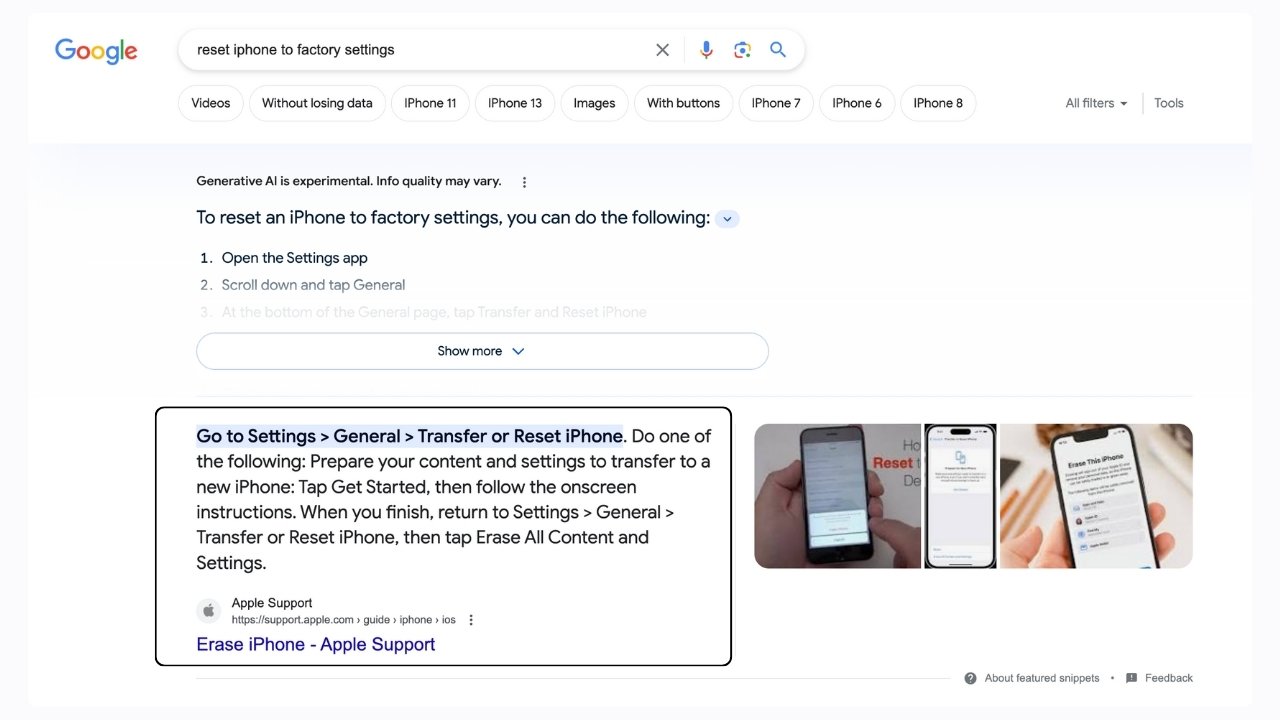
Ongoing conversations, content development, and links help boost domain authority and search rankings. This increases visibility and traffic from Google searches related to your brand and topics.
Give members reasons to link to your community from external sites and profiles. Getting niche influencers and industry publications to cite your community also drives referral traffic.
Ensure your community platform and structure are optimized for SEO, with quality metadata, schema markup, alt text, and internal linking. Produce topic-focused evergreen content like guides around community interests.
Strategic online communities generate value across all stages of the customer lifecycle. When managed effectively, they become self-sustaining assets that pay dividends through continual organic engagement.
The Challenges of Building an Online Communities
Online communities provide valuable opportunities to engage customers, gain insights, and drive brand awareness. However, brands must be ready to handle the common challenges of cultivating an active digital community platform.
| Challenge | Description |
|---|---|
| The risk of negative sentiment | Unhappy customers may use the community to voice complaints and spread negative opinions. Community managers must learn to properly address these situations. |
| The need for moderation | Without active moderators, conversations can quickly veer off-topic or become unproductive. Moderators keep discussions on-track and engaging. |
| Dealing with trolls | “Trolls” intentionally try to disrupt communities by provoking reactions and spreading negativity. Have a plan to minimize their impact on legitimate members. |
| “Trolls” intentionally try to disrupt communities by provoking reactions and spreading negativity. Have a plan to minimize their impact on legitimate members. | Creating a successful community requires an investment of resources for software, staffing, strategy, and long-term management. Underfunding it can lead to failure. |
Risk of Negative Sentiment
When you provide a public forum, customers will inevitably use it to voice complaints about unsatisfactory experiences with your brand. This negative feedback gets amplified as members share frustrations.
To limit damage, monitor conversations closely for emerging complaints. Respond promptly and constructively to validate concerns and offer solutions. Policies should allow negative feedback while barring personal attacks toward your brand or community members.
Accept that you can’t please everyone. Focus instead on addressing issues to rebuild trust with dissatisfied customers. Handled effectively, negative feedback presents opportunities to improve.
Community Management & Moderation
Without active moderators, community conversations easily veer off-topic or turn unproductive. You need people overseeing discussions, guiding engagement, and ensuring interactions remain focused and valuable.
Consider a combined approach using community managers and volunteer moderators from your membership base. This blends professional community-building know-how with the passion of members naturally invested in the community’s success. Managers and moderators should coordinate closely when planning content, facilitating interactions, setting policies, and addressing issues. Consistent activity and monitoring are required to nurture a thriving long-term community.
Dealing with Trolls
“Trolls” who intentionally antagonize other members for reactions can quickly sour the broader community experience. Anonymity on social platforms emboldens some to troll, but ignoring bad actors won’t make them go away.
Use ban protocols for those aiming to disrupt versus contribute. For borderline cases, respond with understanding rather than confrontation. Trolls crave attention, so disengage and divert the conversation elsewhere. Empower members to report trolling activity as soon as it arises. Acknowledge that some trolling is inevitable, then focus on fostering positive interactions between constructive members who make the community valuable.
Challenges with building online communities include keeping members engaged (55%), quantifying value (44%), lack of resources (41%), and integrating with other channels (37%) (source)
Building Communities is Expensive
Developing and maintaining an active online community requires substantial investments of time, resources, and staffing. The community will flounder if you aren’t fully prepared for the scope of commitment involved.
Budget adequately for community management salaries, software costs, content production, incentives, and other operational expenses. Commit an internal team to oversee strategy, governance, technical needs, and marketing. View community investment as a long-term play that builds equity in member relationships and engagement. Sustained resources and attention lead to self-sustaining communities that deliver compounding returns.
While challenges exist, proactive planning and commitment to ongoing support pave the way for impactful, thriving online brand communities. Keep the end goal in mind: deeper customer connections.
Types of Online Communities in Business
There are many different types of online communities that brands can use to create engagement and build brand advocacy.
| Type | Description | Benefits | Challenges |
|---|---|---|---|
| Social community | Platforms like Facebook, LinkedIn, Twitter that allow users to connect and share content. | Leverage existing large user bases. Tie into social media marketing. | Compete for attention. Don’t control data/experience. |
| Social media groups | Smaller subgroups within social platforms based on interests. | More intimate engagement. Shared passions/experiences. | Can be difficult to gain traction. Require active management. |
| Q&A communities | Platforms for asking and answering questions on topics. | Share expertise. Increase brand awareness. | Time investment in ongoing participation. |
| Customer communities | Spaces for customers to discuss products and brands. | Direct feedback. Peer support. Build loyalty. | Risk of negative comments. Require moderation. |
| Developer communities | Connect developers to share code and solve problems. | Feedback on tools. Foster innovation. | Complex conversations. Need technical moderators. |
| Branded communities | Connect customers around a shared interest/brand. | Control experience. Build relationships. | Challenging to attract and retain members. |
| Invite-only communities | Exclusive groups, often for beta testing. | VIP access. Quality feedback. | Perception of exclusivity. Limited reach. |
| Micro-communities | Focused around a niche interest/hobby. | Targeted engagement. | Difficult to gain critical mass. Content gaps. |
Social Communities
Social platforms like Facebook, Twitter, and LinkedIn enable people to connect, share content, and interact around common interests. Brands leverage these public communities to engage broader audiences. For example, Taco Bell has over 1.5 million Twitter followers that they entertain with humorous social content.
However, social media conversations often lack depth. The public nature and broad user bases limit opportunities for meaningful branded interactions. So brands supplement platforms like Facebook and Twitter with more intimate owned communities tailored to their niche audiences.
Still, social communities remain crucial touchpoints for brands. They provide vast exposure and ways to give your brand personality. Regularly sharing entertaining or helpful social content is table stakes for digital engagement. Driving followers to your owned communities can convert passive viewers into active brand advocates.
Social Media Groups
Many social networks offer ways to spawn smaller groups about specific topics. LinkedIn Groups unite professionals in industries to network and discuss relevant issues. Facebook Groups rally people around hobbies, locations, or affiliations.
These social subgroups provide a more focused setting for brands to foster conversations between passionate followers. REI’s Facebook Group connects almost a million outdoor enthusiasts to share adventures and advice.
Social media groups make it easy for niche brand fans to come together on existing platforms they already frequent. While smaller than public feeds, groups can still leverage the broader network effects of the social platform. This allows brands to segment audiences while benefiting from the built-in tools and distribution channels.
Moderating conversations and activities remains important in group settings. However, the more intimate environment lends itself to building relationships between members and brands. Brands create mini-communities within social platforms before guiding users to fully-owned branded communities.
Q&A Communities
Q&A forums like Quora and Reddit enable crowdsourced exchanges of questions and answers on every imaginable topic. Brand experts can demonstrate thought leadership by weighing in on relevant discussions.
SaaS company HubSpot, for example, contributes marketing and sales advice on Quora to reach interested prospects organically. This showcases their expertise while directing traffic back to the HubSpot blog.
Participating in external Q&A communities allows brands to tap into interested audiences and insert their knowledge into existing conversations. Make sure to provide genuine value, not just promotional content. Done right; this elevates your brand as a credible industry resource.
Customer Communities
Dedicated customer communities facilitate peer-to-peer support and feedback about products. Companies like Apple and Starbucks build branded online forums to manage customer issues and nurture loyalty.
User-generated content and conversations offer authentic insights into customer sentiment and needs to guide company decisions. Community activity also boosts SEO and deflects support costs.
Moderators play a key role in managing negative feedback and keeping conversations constructive. But properly nurtured customer communities become self-sustaining assets as helpful members volunteer assistance.
Developer Communities
Developer sites like GitHub and Stack Overflow help programmers learn, collaborate, and troubleshoot code. Tech brands cultivate their communities to provide tools and support for users building on their platforms.
AWS Activate brings students and startups together to learn cloud skills. Google Cloud Developer Community enables users to discuss its products and programs.
Developer communities require specialized content and discussion forums tailored to technical users. But they crucially facilitate third-party innovation that expands the capabilities and adoption of your developer products and platforms.
Branded Communities
Branded communities create spaces for customers to connect over their shared affinity for a company. Nike built an online member hub offering training programs, rewards, and exclusive experiences tied to its products. These owned platforms strengthen emotional attachments to the brand by integrating it into consumer lifestyles and identities beyond just transactions.
Branded communities differ from social channels in focusing exclusively on the brand. This allows you to cultivate deeper relationships beyond transient social interactions. Fully controlled platforms enable integration with customer data, CRM systems, and branded content.
There are several examples of online communities, but the Salesforce community should be the benchmark. The Salesforce Trailblazer Community is an online platform that unites Salesforce users, developers, partners, and enthusiasts. It allows members to connect, learn, collaborate, and support one another on their journeys to becoming Salesforce Trailblazers.
Several features and activities define the Trailblazer Community experience:
- Discussion forums – Members can engage in topic-based forums to ask questions, troubleshoot issues, share best practices, and discuss all aspects of the Salesforce ecosystem.
- Groups – Specialized groups exist for specific Salesforce products, industries, job roles, and geographic regions. This lets members network with peers facing similar use cases.
- Knowledge sharing – The community wiki provides documentation and resources created by members to document their Salesforce expertise.
- Mentorship – New and seasoned members benefit from mentor/mentee relationships and leadership opportunities.
- Certification help – Members pursue prestigious Salesforce certifications with support from study groups, mock exams, and mentors.
- Career development – The community provides training, job boards, and networking to help members advance their Salesforce careers.
- Events – Local, regional, and global TrailheaDX and user group events enable in-person networking opportunities.
By uniting a diverse Trailblazer ecosystem, the community fosters collaboration and continuous learning. Members at all stages of their Salesforce journey find the support and resources to thrive. The community embodies Salesforce’s “Ohana” culture of inclusion and knowledge sharing.
Invite-Only Communities
Companies use exclusive communities to solicit feedback from select groups like beta testers before public launch. This allows brands to refine offerings based on usage among target segments.
Dropbox’s early adopters provided insights to optimize features and identify bugs. Invite-only groups help validate concepts with a trusted test group before mass promotion.
The more exclusive nature of closed communities enhances engagement from special members granted access. However, brands should communicate paths to open participation over time via referrals or other eligibility criteria.
Micro-Communities
Niche micro-communities attract people dedicated to specific activities and interests related to a product or lifestyle. Nikon’s image-sharing community engages photographers invested in the brand’s gear.
Targeted micro-communities enable tailored experiences and content while filtering for highly engaged brand devotees. However, niche focus limits overall reach and growth potential.
Micro-communities effectively serve super users but may not appeal to more casual customers. Complement these niche groups with broader brand communities encompassing your wider audience while directing micro-community members to evangelize.
These are just a few ideas to get you started. Establishing metrics to track the online community’s success over time is essential. Of course, building an online community takes effort. But the value is connecting with customers and creating a loyal following.
Types of Hosted Online Communities
Hosted online community platforms provide the core features and functionality required to get your community up and running quickly. This allows you to focus on attracting members and facilitating engagement rather than managing complex technical infrastructure.
Hosted community platforms offer several advantages over custom-built options:
- Speed and simplicity: Get started faster by leveraging existing technology rather than building from scratch. Focus on your community, not the underlying plumbing.
- Robust feature sets: Access specialized tools designed specifically for community building and engagement right out of the box.
- Best practices: Hosted platforms reflect learnings and expertise from running many communities over time.
- Flexibility: Add or remove features and customize the experience as your community evolves.
- Cost-effectiveness: No need to devote resources to developing and maintaining your platform. Pay only for what you use.
- Community expertise: Many providers offer additional services to help manage, moderate, and promote your community.
The bottom line is that hosted community platforms reduce the heavy lifting, so you can focus on nurturing the connections and interactions that truly matter for your brand.
Influitive

Influitive is a software platform designed to help businesses increase customer advocacy and engagement. The solution leverages gamification, rewards, and community-building tools to mobilize customers, partners, and employees to drive referrals, references, reviews, social shares, product feedback, and more for a brand. Key capabilities provided by Influitive include an advocate community hub with gamified tiers and challenges, streamlined referrals and references management, social sharing and amplification, ideation and feedback gathering, knowledge base and peer networking, and integrations with complementary solutions like CRM and marketing automation.
Benefits of Using Influtitive
Influitive offers several benefits for brands looking to boost customer-centricity. The platform drives higher levels of customer engagement and advocacy by incentivizing brand promotion through gamification and community. It provides a means to gather customer insights to refine products and marketing through built-in feedback channels and discussions. Influitive also generates more referrals, references, and reviews by rewarding and recognizing top advocates. Additionally, it amplifies brand reach and voice by making it easy for satisfied customers to share content and experiences on social media. By keeping customers engaged over time, Influitive reduces churn and increases lifetime value. The community hub and peer networking features further enable valuable connections between customers themselves.
Influtitive Reviews
Influitive receive highly positive reviews on trusted software review platforms. It holds a 4.4 out of 5-star average rating on G2 based on over 230 user reviews. On Capterra, Influitive’s average rating is 4.7 stars across 245 reviews. Positive feedback cites the platform’s ease of use, stellar customer support, functionality, and proven ability to drive results. Some reviewers mention occasional bugs and desired feature improvements as areas for improvement. But overall, the consensus is that Influitive delivers on its promise to increase customer advocacy and engagement.
Influtitive Use Cases
Common use cases for Influitive include building customer loyalty and advocacy programs, streamlining referrals and references management, gathering product feedback and inputs for road mapping, facilitating peer knowledge sharing and support, and amplifying social media engagement and reviews. The platform provides a robust set of capabilities purpose-built to drive greater customer centricity in these areas.
Gainsight
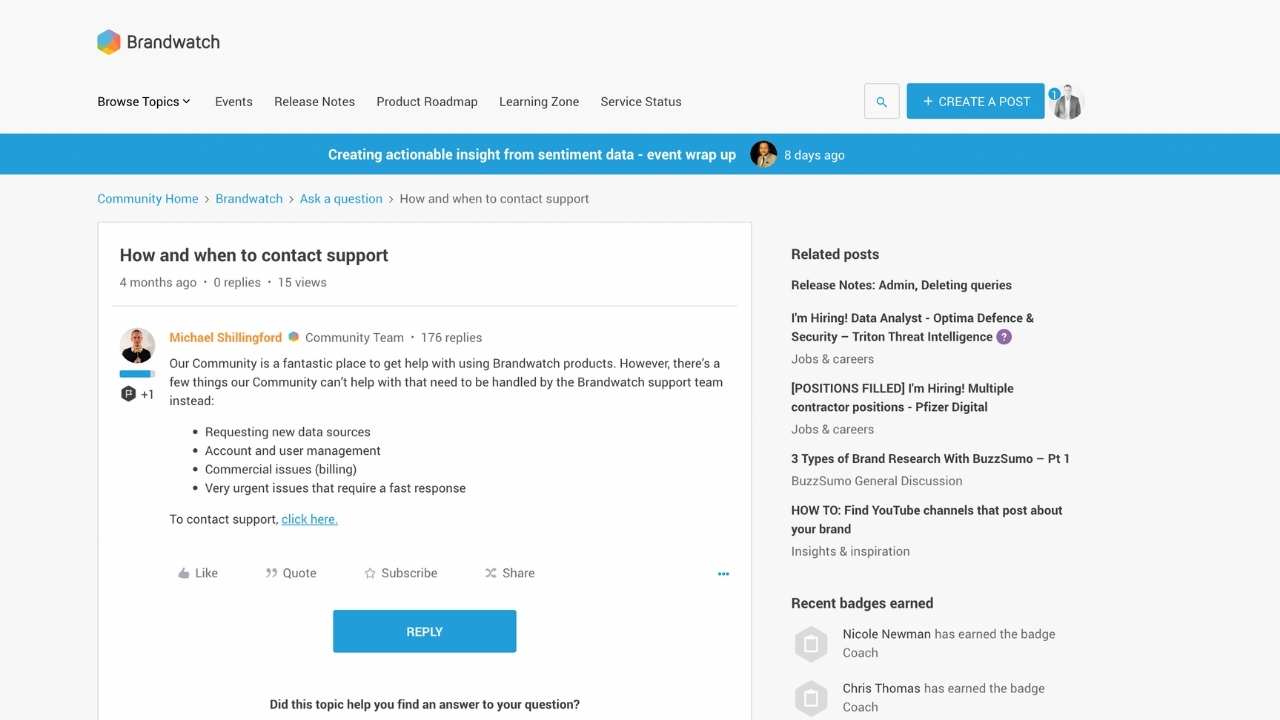
Gainsight is a software platform that drives customer advocacy and engagement for B2B brands. It helps companies mobilize customers, partners, and employees to provide referrals, references, reviews, social shares, feedback, and other forms of promotion. To increase involvement, Gainsight utilizes gamification, tiered rewards, and community-building features within the platform. Key capabilities include an advocate community hub, gamified tiers and challenges, streamlined referrals and references management, social sharing and amplification tools, ideation, and feedback channels, a knowledge base, CRM integration, and more.
Gainsight Benefits
Gainsight offers several benefits for brands aiming to boost customer-centricity. The platform drives higher levels of customer engagement and advocacy by incentivizing brand promotion through gamification techniques and community. It gathers customer insights to refine products, marketing campaigns, and strategic direction based on feedback channels built into the platform. Gainsight also generates more referrals, references, and reviews by motivating and recognizing top advocates. Additionally, it provides tools to amplify brand reach and voice by facilitating social sharing. By increasing engagement over time, the platform reduces customer churn and increases lifetime value. Peer networking features also enable valuable connections between customers themselves.
Gainsight Reviews
Gainsight receives highly positive reviews on trusted software review platforms like G2 and Capterra. It holds a 4.4 out of 5-star average on G2 based on hundreds of ratings. On Capterra, the average rating is 4.7 stars. Users praise the platform for its ease of use, stellar customer support, robust functionality, and proven ability to drive results. Some mention occasional bugs and desired feature improvements as areas for improvement. However, the consensus is that Gainsight delivers on driving customer advocacy.
Gainsight Use Cases
Common use cases include building customer loyalty/advocacy programs, streamlining referrals and references, gathering product feedback and inputs for road mapping, facilitating peer knowledge sharing and support, and amplifying social media engagement and reviews. The platform provides a broad toolset purpose-built for increasing customer centricity across these areas.
Mighty Networks
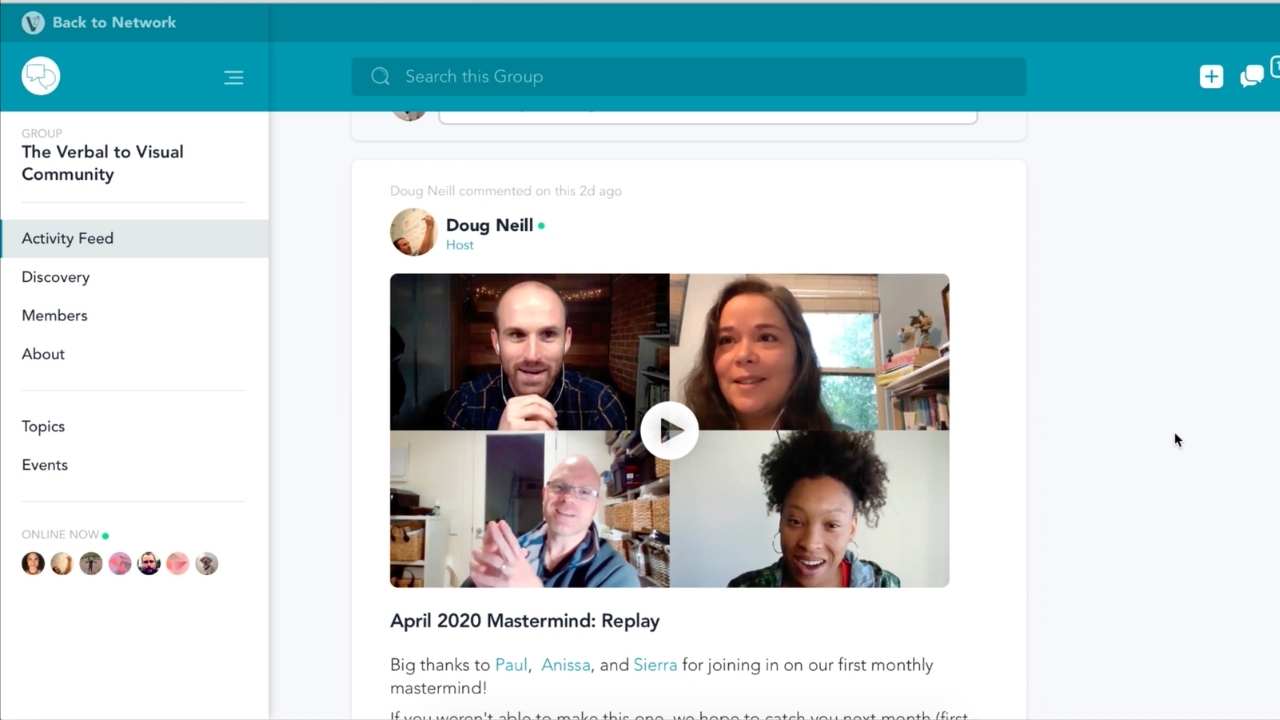
Mighty Networks is an online community platform that enables creators, businesses, organizations, and others to build private social network websites. It provides the tools to develop engaged online communities, create and sell online courses, host virtual events, offer paid memberships, and more.
Mighty Network Features
Mighty Networks provides several key features to build robust communities and monetize them. These include spaces to organize communities into different sections like forums, subgroups, courses, and more. There are options to create diverse multimedia content like posts, articles, and videos. Live streaming allows hosts to broadcast video only viewable by members. Group chats enable private messaging between community members.
To monetize communities, Mighty Networks enables building online courses with cohorts, lessons, quizzes, and other content. There are also capabilities to offer paid memberships and gate access to premium content or community sections. Native iOS and Android apps allow members to participate on their mobile devices.
Mighty Network Benefits
Mighty Networks offers several benefits for community builders. It provides the tools to develop highly engaged niche communities around specific interests or niches. Creators can monetize their expertise and content through paid memberships and online courses. It allows owners to build communities on their platform rather than relying on third-party sites. Mobile apps increase engagement by enabling access anywhere. Powerful analytics provide data to make informed decisions about growing your community.
Mighty Network Use Cases
Mighty Networks can facilitate many types of communities. Examples include online courses and coaching communities, paid membership sites, alumni and non-profit communities, employee networks and intranets, and niche hobby and interest groups. The platform is flexible enough to support diverse community types and business models.
In summary, Mighty Networks empowers creators to develop customized social communities, monetize them through premium content and offerings, and own the platform. It provides robust tools to build and manage engaged niche communities.
Bettermode
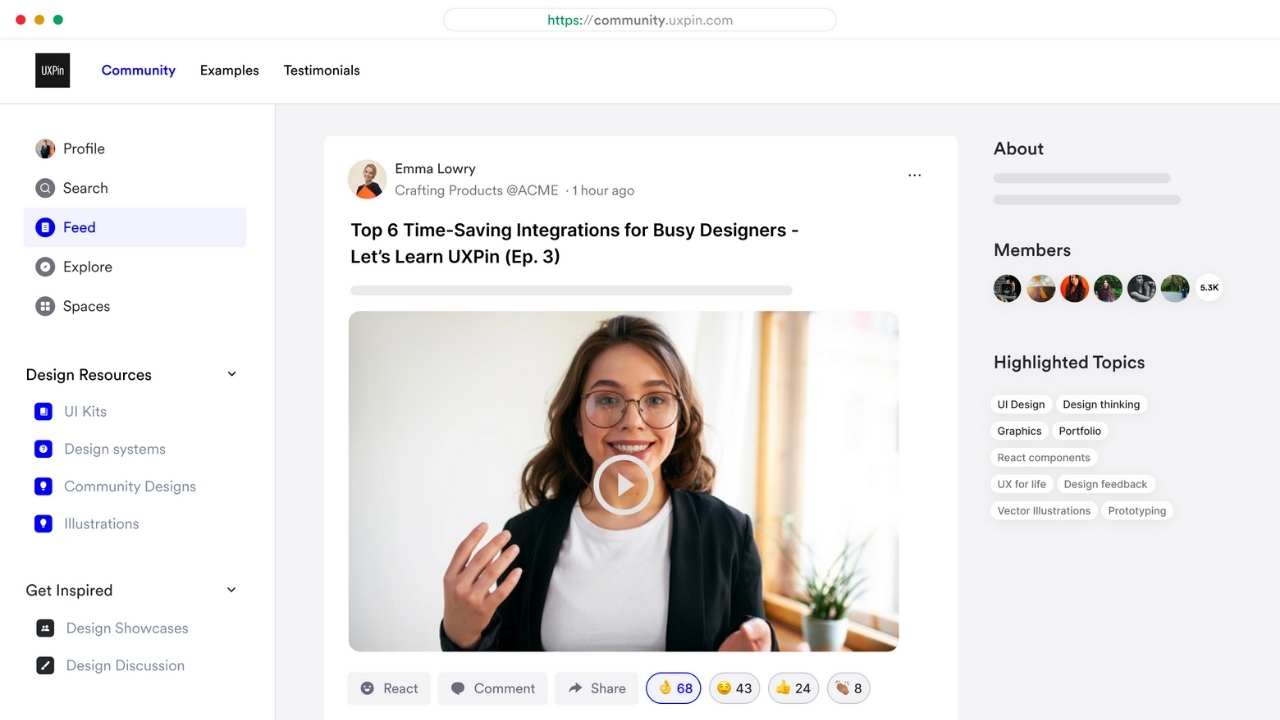
Bettermode (formerly Tribe) is a cloud-based, customizable online community platform that enables businesses, organizations, creators, and more to build their private social networks. It provides a robust set of features like activity feeds, discussions, subgroups, events, courses, member profiles, gamification, moderation tools, analytics, integrations, widgets, APIs, and more.
Bettermode allows community owners to create public and private communities embedded into existing websites/products or offered as standalone platforms. This flexibility makes it suitable for diverse use cases.
Bettermode Benefits
Bettermode offers several key benefits. It helps engage and retain users by facilitating social interactions around shared interests. Community owners can monetize access via subscriptions, online courses, virtual events, and more. Bettermode also provides data ownership, unlike external social media platforms.
The platform is highly customizable, with white-label branding options to match existing properties. It is developer-friendly, with APIs and widgets for easy integration with other tools.
Bettermode Reviews
On Capterra, Bettermode is rated 4.8/5 stars based on over 80 user reviews. It has been praised for its customizability, easy setup, design, and customer support.
In summary, Bettermode provides a full-featured and customizable community platform suitable for diverse use cases. It enables building private social networks with solid reviews. Bettermode offers an alternative to relying solely on external social media sites for community interactions.
Bettermode Use Cases
Bettermode supports various uses, including niche social networks, customer communities, alumni groups, member associations, employee networks, coaching communities, paid membership sites, and more.
Khoros Communities
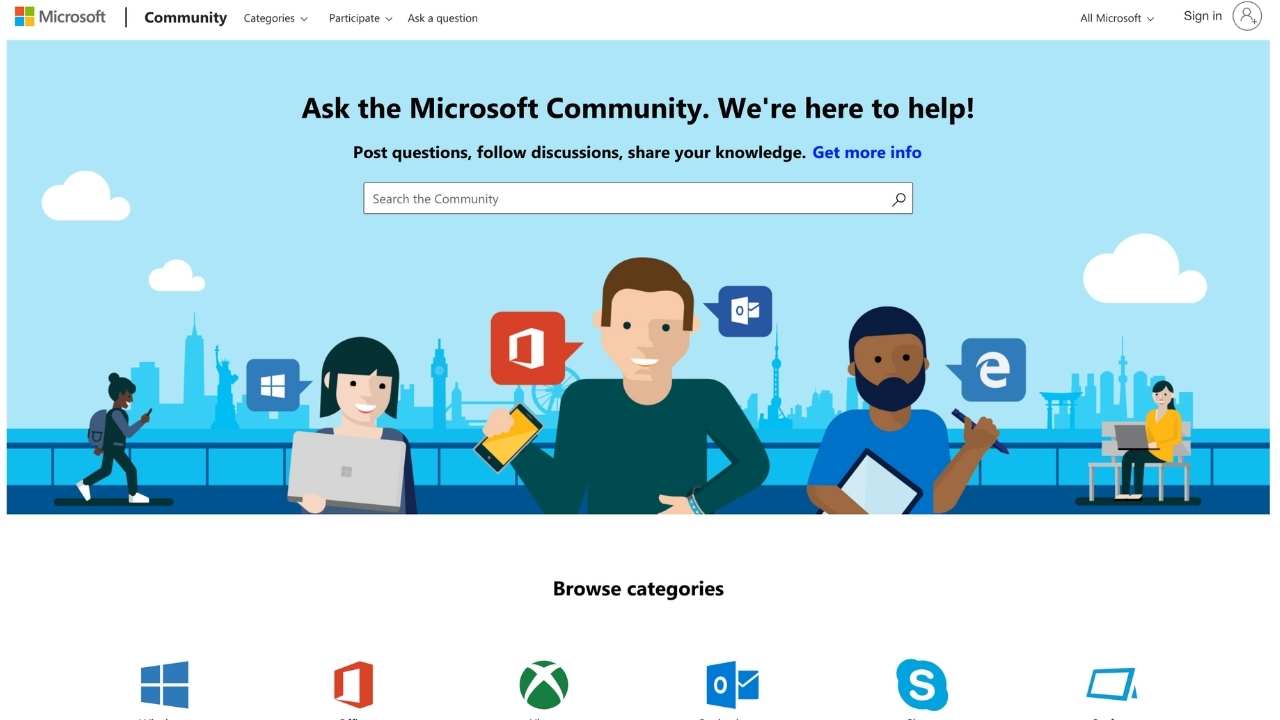
Khoros is a digital customer engagement platform designed to help brands connect with customers across digital channels, including social media, messaging, online communities, and contact centers. The company offers three main solutions:
- Khoros Care, which is a digital contact center with social media management, messaging, AI chatbots, and omnichannel routing
- Khoros Communities, which is an online community platform for customer forums, peer support, and discussions
- Khoros Marketing, which provides social media management, publishing, listening, and analytics tools
Khoros Key Features
Key features of Khoros solutions include an omnichannel digital contact center, social media publishing, monitoring and analytics, an online community platform for customers, AI-powered chatbots for automated conversations, workflow automation between platforms and teams, and integrations with CRM, marketing automation, etc.
Khoros offers benefits like improving customer experience across digital touchpoints, driving higher engagement on social media and online communities, automating repetitive support tasks through AI chatbots, providing actionable customer insights, reducing customer support costs, and enabling peer-to-peer customer engagement in communities.
Khoros Reviews
Khoros consistently receives positive reviews on sites like G2 and Capterra. The platform is praised for its ease of use, robust features, great customer support, and proven ability to drive results. Khoros provides an integrated digital customer engagement platform combining a contact center, social media, and community capabilities to connect brands with customers across key digital channels.
Final Thoughts: Online Communities for Business
For years, there has been growing discussion around brands migrating from mass social media networks to owned online communities. Part of the rationale is the lack of control on external platforms. This isn’t meant negatively, but social networks like Facebook and Twitter can enforce policies or algorithms restricting brands’ ability to reach their audiences organically. We’ve seen this play out over time as organic social reach has diminished.
While social media remains crucial for awareness, brands increasingly explore owned online communities to foster deeper, more intimate customer relationships beyond transient social interactions. There are several motivations for this shift:
First, branded online communities offer a space tailored to a brand’s audience, values, and goals. Companies can cultivate an ecosystem where peer-to-peer conversations and connections manifest independently, anchored by a shared affinity for the brand. This helps embed the brand within the customer’s lifestyle.
Second, owned communities facilitate continual two-way dialogues that provide customer insights and amplify word-of-mouth advocacy. Members interact meaningfully instead of just passively consuming content.
Third, online communities strengthen bonds between customers themselves. They fulfill people’s inherent need for belonging by uniting them around shared interests and experiences.
Finally, branded communities allow the integration of engagement data with CRM systems for a holistic view of the customer journey. Companies gain control over community data, metrics, and experiences.
In summary, online brand communities help foster loyal brand advocates who voluntarily promote and enrich the community. By proactively building these owned spaces, companies take charge of cultivating strong customer relationships.
FAQ
Some examples of topical-based online communities include Elpha, an online community dedicated to helping women succeed at work together. The Next CMO is another online community that allows marketing professionals to keep up with the latest trends.
The best way to find a topical-based community is to search for one that matches your interests. For example, if you’re interested in marketing, you can search for “marketing communities” on Google.
Below is an example of the SAP-branded online community. You’ll notice user registrations, the ability to answer and ask questions, and over 132K blog posts. SAP has built a destination for its customers, partners, and prospects to learn more about SAP technology and connect with other technologists.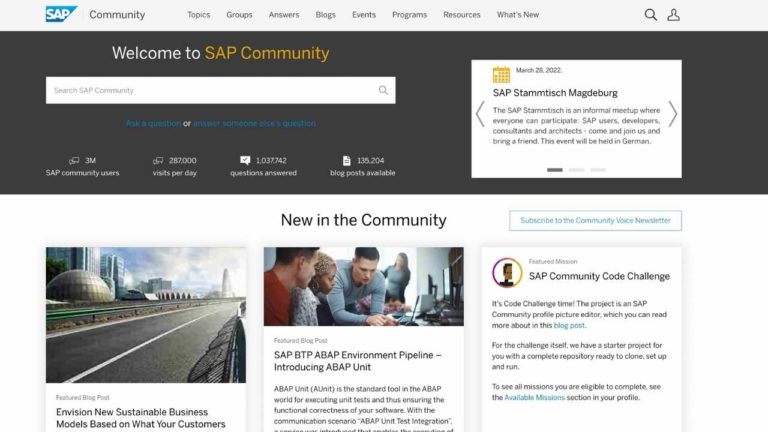
Apple Support Community is probably the best example. Have you ever had an issue with your iPhone, and you couldn’t figure out how to turn off notifications, connect to Bluetooth, or maybe even hard reset the phone itself? You probably spent some time on the Apple communities. If you’re anything like me, you Google the exact problem you are having, and ten times out of 10, you will receive the exact answer you’re looking for.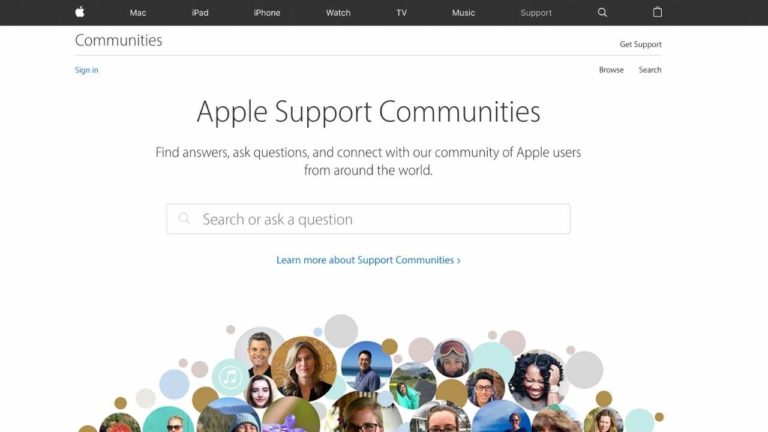
One study found that 66% of people prefer online communities because they can connect with others with similar interests.
Community management is essential to online communities because it helps keep them organized and running smoothly. It also helps keep the community members engaged and enthusiastic about participating with new members.
A support team should be very involved with an online community. They can help moderate discussions, help with community management, answer questions, and provide valuable feedback to community members.
Enterprise customer communities can help companies build customer relationships, increase customer loyalty, and reduce customer service costs. Additionally, customer feedback from community members can help organizations improve their products and services.
A micro-community is an online community of a few individuals who share a common belief system, values, or interests. It’s usually a sub-segment of a larger community on the Internet. More sophisticated marketers understand the importance of finding those nuances in conversation and uncovering customer needs online. Then, use that data to inform the community about content they are soliciting, creating, and publishing online
